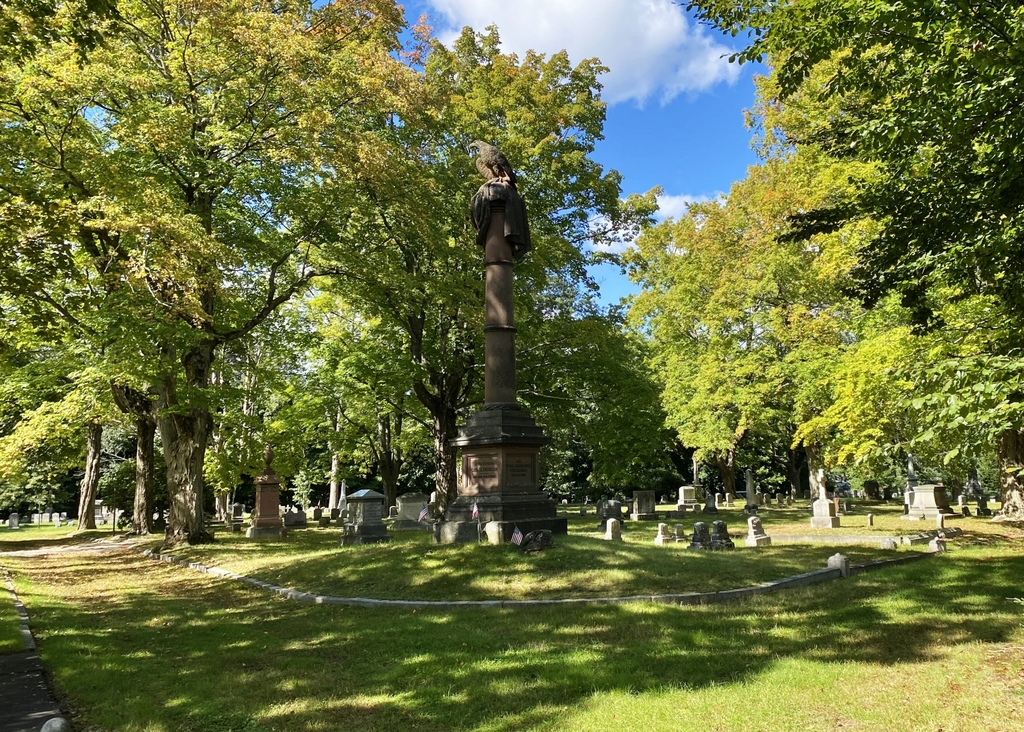The monument at the gravesite of George B. Boomer at Rural Cemetery in Worcester, Massachusetts, around 1895. Image from Picturesque Worcester (1895).
The scene in 2021:
These two photos show the gravesite of George B. Boomer, a Civil War officer who was killed in action during the Siege of Vicksburg on May 22, 1863. Born in Sutton, Massachusetts in 1832, Boomer grew up in the Worcester area, but later moved west to St. Louis, where he was involved in bridge building. Upon the outbreak of the Civil War, he found himself in a border state that had divided loyalties. Missouri ultimately remained in the Union, as did Boomer, who helped to raise a regiment of Missouri soldiers.
Boomer was commissioned as colonel of the 26th Missouri Infantry Regiment in 1862. He suffered serious wounds at the Battle of Iuka in September 1862, but after his recovery he returned to action, including participating in the Vicksburg campaign. Vicksburg proved to be a major turning point for the Union during the war, and Boomer fought with distinction, including at the Battle of Champion Hill, a major Union victory on May 16, 1862 that directly led to the Siege of Vicksburg. He was also involved in the Battle of Big Black River Bridge on the following day, and in the assault on Vicksburg itself on May 22. However, this assault proved unsuccessful, and the Union sustained many casualties, including Boomer, who was killed instantly by a gunshot wound to the head.
He was initially buried in Louisiana, then in St. Louis, before his remains were eventually returned to Worcester. His funeral was held at the Third Baptist Church on June 28, and he was subsequently buried here in Rural Cemetery. Less than a week later, on July 4, Union forces finally succeeded in taking the city of Vicksburg. This, combined with the Confederate defeat at Gettysburg a day earlier, proved to be a decisive blow that the Confederacy was never able to recover from.
George Boomer would ultimately be memorialized here by the large monument that is shown here in these two photos. It is 27 feet tall, carved of Connecticut sandstone, and it takes the form of an ancient Roman victory column with a large eagle at the top. It was designed by local sculptor and gravestone carver Benjamin H. Kinney, and it was installed here in early 1865, shortly before the end of the Civil War. On the monument, he is referred to by the rank of Brigadier General, as do many other contemporary accounts of his military career. However, it seems unclear as to whether he actually received this promotion, because other sources indicate that the highest rank that he held was that of colonel.
The first photo was taken about 30 years after the monument was installed here, and more than 125 years have passed since then. During this time, very little has changed here except for the landscaping of the cemetery, which now features much larger trees than in the first photo. Otherwise, though, the cemetery looks much the same as it did in the 1890s, and many of the gravestones from the first photo are still easily recognizable in the present-day photos, including the Boomer memorial, which still stands as one of the most distinctive monuments in the cemetery.



I used to live on North St, right next to this cemetary. it’s interesting to learn the history of these monuments I’ve seen so many times
This is a very impressive monument indeed. It is a very short distance from colonel Ward. 15 th Massachusetts Vols, who was killed at Gettysburg a few days later. The Grand Army of the Republic post 10 was named after him.
John J Rice,Sr.
Worcester detachment Marine Corps League